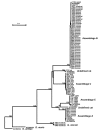Triosephosphate isomerase gene characterization and potential zoonotic transmission of Giardia duodenalis
- PMID: 14718089
- PMCID: PMC3035538
- DOI: 10.3201/eid0911.030084
Triosephosphate isomerase gene characterization and potential zoonotic transmission of Giardia duodenalis
Abstract
To address the source of infection in humans and public health importance of Giardia duodenalis parasites from animals, nucleotide sequences of the triosephosphate isomerase (TPI) gene were generated for 37 human isolates, 15 dog isolates, 8 muskrat isolates, 7 isolates each from cattle and beavers, and 1 isolate each from a rat and a rabbit. Distinct genotypes were found in humans, cattle, beavers, dogs, muskrats, and rats. TPI and small subunit ribosomal RNA (SSU rRNA) gene sequences of G. microti from muskrats were also generated and analyzed. Phylogenetic analysis on the TPI sequences confirmed the formation of distinct groups. Nevertheless, a major group (assemblage B) contained most of the human and muskrat isolates, all beaver isolates, and the rabbit isolate. These data confirm that G. duodenalis from certain animals can potentially infect humans and should be useful in the detection, differentiation, and taxonomy of Giardia spp.
Figures



References
-
- Filice FP. Studies on the cytology and life history of a Giardia from the laboratory rat. Univ Calif Publ Zool. 1952;57:53–46.
-
- Feely DE. Morphology of the cyst of Giardia microti by light and electron microscopy. J Protozool. 1988;35:52–4. - PubMed
MeSH terms
Substances
LinkOut - more resources
Full Text Sources
Medical
Miscellaneous
